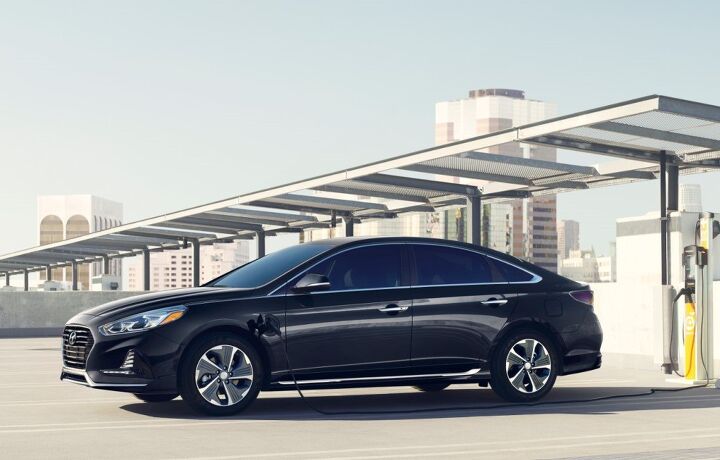Plug-in or Not, Hyundai Doesn't Want to Be Seen as the Expensive Choice

Exclusivity is not a word often associated with Hyundai, and with good reason. Like Nissan (but even more so), Hyundai’s reputation is built on a foundation of mass-produced vehicles with inherent value. And, even in the world of green cars, it seems that game plan can’t change.
So, it’s no surprise to see Hyundai take a hatchet to the price of its 2018 Sonata Plug-in Hybrid. In dropping the model’s entry price by $1,350 and adding one mile of electric driving range, Hyundai hopes it’s enough to attract the attention of would-be buyers. It needs to. In June, the model sat at 21st place on the public’s PHEV shopping list.
Starting now, a Sonata PHEV will set you back $33,350 before a $885 destination charge, while the Limited model grows $250 to $38,850 before destination.
For the base sticker, you’ll see the same 2.0-liter inline four and 50 kWh electric motor, the latter of which is good for 67 horsepower. The transmission remains a six-speed automatic. Hyundai now claims an EV driving range of 28 miles, up from the 27 advertised when the 2018 model debuted at the Chicago Auto Show. Any improvement is a good one, we suppose.
While cutting the entry price obviously adds value to the base model, the Limited’s slight price hike brings many new features aboard — LED headlights with “Dynamic Bending Light,” automatic emergency braking with pedestrian detection, a heated steering wheel, Driver Attention Alert, a wireless charging pad, and a USB port for rear seat passengers.
In a market awash with plug-ins, how has the Sonata fared? Not well, compared to other low-priced PHEVs. Granted, the 2018 model launched well after its Hybrid sibling, meaning that buyers could only source the old-style previous-generation model (even as the stock gasoline-only Sonata’s new design became old hat).
In June, Hyundai sold just 62 Sonata Plug-in Hybrids, a year-over-year drop of 29.5 percent. Over the first half of 2018, the model’s volume shrank by 28.9 percent. Even the plug-in version of the Kia Optima sells better. Year to date, Ford sold more than ten times as many Fusion Energi sedans.
The base Fusion Energi SE, which carries a range of 21 electric miles, stickers for $31,400 before destination — nearly two grand less than the new, cheaper Sonata PHEV.
[Images: Hyundai]

More by Steph Willems
Latest Car Reviews
Read moreLatest Product Reviews
Read moreRecent Comments
- Lou_BC Well, I'd be impressed if this was in a ZR2. LOL
- Lou_BC This is my shocked face 😲 Hope formatting doesn't fook this up LOL
- Lou_BC Junior? Would that be a Beta Romeo?
- Lou_BC Gotta fix that formatting problem. What a pile of bullsh!t. Are longer posts costing TTAC money? FOOK
- Lou_BC 1.Honda: 6,334,825 vehicles potentially affected2.Ford: 6,152,6143.Kia America: 3,110,4474.Chrysler: 2,732,3985.General Motors: 2,021,0336.Nissan North America: 1,804,4437.Mercedes-Benz USA: 478,1738.Volkswagen Group of America: 453,7639.BMW of North America: 340,24910.Daimler Trucks North America: 261,959



































Comments
Join the conversation
I would gladly pay more for more horsepower. I imagine a bigger motor + battery would cover that price drop, add range, and give these kinds of cars decent acceleration without affecting gas mileage. I want a hybrid for my next car, but it's gotta run a 14 second quarter mile and burn regular gas. I honestly don't think such a car exists.
Unless gas prices go up more (and stay) up, most drivers (not in high gas price areas) won't see a return on a PHEV. Even a regular hybrid system take years to see a return; however, a 48V mild hybrid system would benefit the typical daily driver.